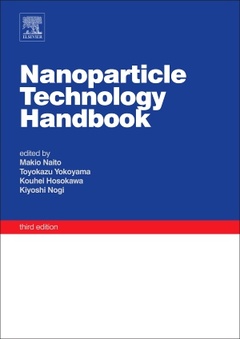Description
Nanoparticle Technology Handbook (3rd Ed.)
Coordinators: Naito Makio, Yokoyama Toyokazu, Hosokawa Kouhei, Nogi Kiyoshi
Language: English
Subject for Nanoparticle Technology Handbook:
904 p. · 21.4x27.6 cm · Hardback
Description
/li>Contents
/li>Readership
/li>Biography
/li>Comment
/li>
Nanoparticle Technology Handbook, Third Edition, is an updated and expanded authoritative reference providing both the theory behind nanoparticles and the practical applications of nanotechnology. This third edition features twenty new chapters, providing a reference much broader in scope than the previous edition. Over 140 experts in nanotechnology and/or particle technology contributed to this new edition. The book not only includes the theory behind nanoparticles, but also the practical applications of nanotechnology. It examines future possibilities and new innovations and contains important knowledge on nanoparticle characterization and the effect of nanoparticles on the environment and humans.
Nanoparticle technology is a new and revolutionary technology, which is increasingly used in electronic devices and nanomaterials. It handles the preparation, processing, application and characterization of nanoparticles and has become the core of nanotechnology as an extension of conventional fine particle/powder technology. Nanoparticle technology plays an important role in the implementation of nanotechnology in many engineering and industrial fields, including electronic devices, advanced ceramics, new batteries, engineered catalysts, functional paint and ink, drug delivery system, biotechnology, etc., making use of the unique properties of nanoparticles, which are completely different from those of bulk materials.
1. Fundamental properties of nanoparticles and their characterization methods 2. Structural control of nanoparticles 3. Properties and behavior of nanoparticles and their dispersed system 4. Control of nanostructure of materials 5. Characterization methods for nanostructure of materials 6. Evaluation methods for properties of nanostructured body 7. Environmental and safety issues with Nanoparticles
For the researchers of universities, institutes and companies engaged in the research of nanoparticles and the related materials and their applications in the field of material science, ceramic, chemical engineering, electronics, biology.
For the students and graduate students in engineering department of universities .
It could also be used for seminar or technical training courses in the field of new materials using nanoparticles
After finishing the Master course at Kyoto University and studying powder technology at Karlsruhe University, Toyokazu Yokoyama has been engaged in mainly R&D work for Hosokawa Micron Corporation in the field of powder technology for nearly 40 years. Finishing the Ph.D. work on the subject of ultrafine wet grinding at Nagoya University, he worked as a general manager of Hosokawa Micromeritics Laboratory. Meanwhile, he published papers and articles and filed patents related with powder and particle technology, and edited some journals and books including the previous versions of Nanoparticle Technology Handbook. Secretary General of Hosokawa Powder Technology Foundation and a Fellow of Powder Technology Research Institute of Hosokawa Micron Corporation. His expertise is in the field of powder and particle technology for processing and characte
- Introduces all aspects of nanoparticle technology, from the fundamentals to applications
- Cover basic information on preparation through to the characterization of nanoparticles in a systematic way
- Features information on nanostructures, which play an important role in practical applications
- Includes the effects of nanoparticles on human health and the environment
- Includes applications of nanoparticles in diverse fields, including applications in new areas, such as electronics cosmetics, etc.
- Offers up-to-date information given by specialists in each field




